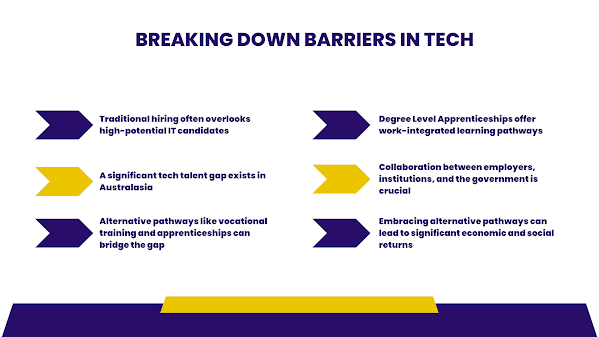Breaking Down Barriers: The Need for Alternative Pathways in Tech
In the rapidly evolving world of technology, there's a growing demand for talent. However, traditional hiring practices might be sidelining a vast pool of potential candidates. A recent Accenture report, commissioned by Microsoft, highlights how businesses are inadvertently filtering out high-potential IT candidates by prioritising university degree holders. This approach overlooks historically under-represented groups such as women, people with disabilities, and First Nations people.
The Tech Talent Gap in Australasia
Australia and New Zealand are both grappling with a significant tech talent gap. For instance, in Australia, for every tech job lost in the direct tech industry, 20 new jobs emerge in the indirect industry. Meanwhile, in New Zealand, 98% of IT employers report experiencing a skills shortage, with 97% of organisations facing ongoing recruitment challenges.
The Potential of Alternative Pathways
The Accenture report suggests that removing barriers could unlock a potential pool of 1.1 million workers in Australia. This is ten times the number needed to fill the current talent gap identified by the Tech Council of Australia. The report advocates for a shift towards a skills-based economy, where aptitude and potential matter more than formal qualifications.
Alternative pathways include vocational training, micro-credentials, bootcamps, apprenticeships, and more. Such pathways align Australia more closely with global counterparts. For instance, US and Canadian statistics show that two in five tech jobs don't require a bachelor's degree.
Degree Level Apprenticeships: A Game-Changer?
In New Zealand, there's a growing recognition of the need for Degree Apprenticeships. Traditionally, apprenticeships in NZ have been associated with trades. However, countries like the UK have expanded this model to include higher education. The prestigious Russell Group of Universities, including the University of Cambridge and Imperial College, have acknowledged the benefits of apprenticeships. These programmes allow students to work while also receiving structured, industry-led training.
For NZ to fully embrace this model, employers, educational institutions, and the government must collaborate. The UK's Office for Students describes degree apprenticeships as programmes where students spend 20% of their time on off-the-job training, taking up to six years to complete. This requires employers to create entry-level roles and the government to provide necessary support.
Conclusion
The tech industry's talent gap can be bridged by rethinking traditional hiring practices and embracing alternative pathways. By doing so, not only can businesses tap into a broader talent pool, but they can also drive significant economic and social returns. It's high time for Australasia to break down barriers and build a more inclusive tech workforce.
Acknowledgements: This article draws insights from a report by Accenture, commissioned by Microsoft, and insights shared in the ITP newsletter NZ. The detailed insights on the topic were sourced from an article on iStart. Special thanks to the ITP mail list for their invaluable contributions.

Comments
Post a Comment